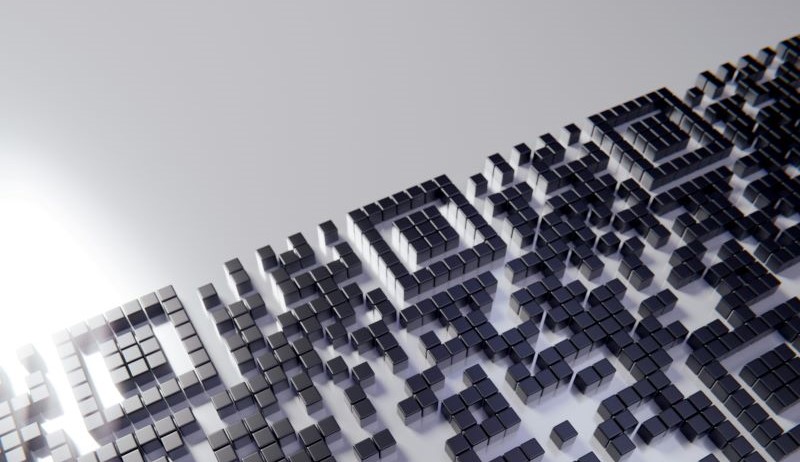What is a 3D QR Code?
A 3D QR code is a three-dimensional adaptation of the traditional QR code, which typically exists in a two-dimensional format. Unlike a standard QR code, which is printed on a flat surface, a 3D QR code is created with depth and can be physically printed using a 3D printer.
This additional dimension allows for a QR code to not only include the usual black and white pixel patterns but also to incorporate a tactile aspect that can be scanned both visually and physically.
This type of QR code is especially useful in situations where durability and a unique aesthetic are required.

What is the Difference Between 2D and 3D QR Codes?
The primary difference between 2D and 3D QR codes lies in their dimensionality. Traditional 2D QR codes are flat, consisting of black squares arranged in a square grid on a white background, readable by most digital devices with a camera.
In contrast, 3D QR codes incorporate an additional spatial dimension, offering physical depth that can be printed and used in a tangible form. This depth not only enriches the aesthetic appeal but also allows for new functionalities and durability that 2D QR codes cannot match.
Benefits of Using 3D Printed QR Codes
● Enhanced Durability: 3D printed QR codes are significantly more resistant to environmental factors such as water, heat, and physical wear compared to traditional paper-based QR codes.
● Customizable Appearance: The ability to design and modify the aesthetic aspects of QR codes in 3D form allows for greater branding opportunities, making them a powerful tool for marketing and identity branding.
● Increased Engagement: The novel and interactive nature of 3D QR codes can capture the interest of users more effectively, leading to increased customer engagement with the content linked to the QR codes.
● Versatility in Usage: Due to their robustness, 3D QR codes can be used in a variety of settings where traditional QR codes might fail, such as outdoor environments, luxury goods, or in manufacturing settings where they might be subjected to rough handling.
How to Create a 3D Printed QR Code?
Creating a 3D printed QR code involves a few detailed steps, from design to the final print. Here's how you can achieve a functional and visually appealing 3D QR code using a 3D QR code generator:
Step 1: Designing Your QR Code
The process begins with the design phase, where you use an online QR code generator to create the initial 2D QR code. This involves selecting the appropriate content for the QR code, such as URLs, and text messages. The content must be not only concise but also strategically formatted to maintain the integrity of the code's scannability.
Step 2: Converting QR Codes for 3D Printing
After designing your QR code, the next step is converting the flat 2D image into a 3D model. This conversion involves using specialized software that translates the black and white squares of a standard QR code into a three-dimensional format that can be recognized and printed using a 3D printer.
Step 3: Preparing Your 3D Model for Printing
The final step before printing is the preparation of your 3D model. This stage is critical as it ensures the functionality of the QR code post-printing.
You must adjust the size and resolution of the model to guarantee it remains scannable by standard QR code readers.
The choice of printing materials also plays a vital role in this phase. Materials should be chosen based on the intended use and exposure of the QR code; for instance, resins and durable plastics are preferred for outdoor or frequent-use items due to their clarity and durability.
By following these steps with the aid of a 3D QR code generator, you can effectively create a QR code that not only serves its functional purpose but also adds a unique, tactile dimension to your digital interactions.
Practical Applications of 3D Print QR Codes
The technological advancement in QR codes has taken a significant leap from traditional 2D codes to innovative 3D printed QR codes. This evolution not only enhances the functionality of QR codes but also expands their application across various industries.
● Event Management: 3D print QR codes can be used as part of innovative event passes or tickets, providing a unique and customizable option for access control that can also serve as a keepsake.
● Marketing Campaigns: Companies can integrate 3D QR codes into promotional items such as merchandise or luxury branding materials, which not only offer practical uses but also serve as interactive marketing tools.
● Educational Tools: In educational settings, 3D QR codes can be utilized in interactive learning materials, where students can scan codes to access supplementary digital content, enhancing the learning experience.
● Personalized Gifts: For personal use, these QR codes can be crafted into gifts such as personalized keychains or jewelry, linking to meaningful messages or videos, adding a layer of personal touch to the present.
Overall, 3D print QR codes represent a blend of traditional digital interaction and modern 3D printing technology, offering many applications in both personal and commercial projects.
For those looking to explore the potential of 3D printed QR codes, visit our QR code generator to start your journey towards innovative digital engagement today!
FAQs
1. Can any QR code be converted for 3D printing?
Yes, but the complexity and size of the QR code must be manageable.
2. What are the best materials for 3D printing QR codes?
Durable plastics or resins are ideal for clear and long-lasting results.
3. How do I scan a 3D print QR code?
Use any standard QR code scanning app on a smartphone.




